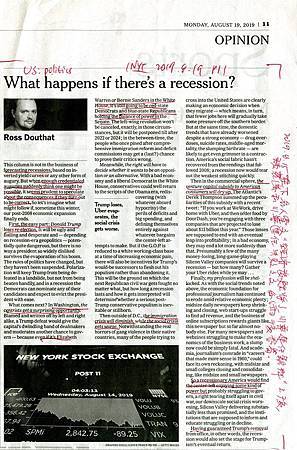巧合的連鎖反應
accessed Sep 5, 2019
台北時間2019.8.15, 即美國時間 2019.8.14, 美國股票道瓊指數猛跌800點,是2019年開年來最嚴重的一次下滑,也是美國歷史上第四嚴重的單日下滑。
原因是美國國債10年的利率(理應高於2年的利率)突然跌破2年的利率。
同一天,在下於聯合報名人堂的拙文"經濟復甦將了,川普連任難料" (2019.8.7開始寫, 2019.8.12交稿)登出。
巧合!
之後,中外掀起一片討論美國經濟將衰退,川普連任有變數的討論
●2019.8.15 林中斌,「經濟復甦將了,川普連任難料」聯合報 頁A13
●2019.8.19 Ruchir Sharma, “ Let’s say goodbye to growth” International New York Times p.11
●2019.8.19 Ross Douthat, “ What happens if there’s a recessions?” International New York Times p.11
●2019.8.19 社論,「川普要贏貿易戰環是選戰?」聯合報 頁A2
●2019.8.23 劉憶如,「榮景近尾聲,山雨欲來」聯合報頁A13
●2019.8.20 魏國金(編輯),「美經濟 最快明年步入衰退」聯合報 頁A8
●2019.9.2 Alan Blinder, “The economy under Trump is very good. But don’t be fooled” Time p.27
●2019.9.2 Douglas Holtz-Eakin, “No, a recession is not imminent” Time p.29
Dow tanks 800 points in worst day of 2019 after bond market sends recession warning
https://www.cnbc.com/2019/08/14/stock-markets-wall-street-in-focus-amid-earnings-economic-data.html
accessed September 5, 2019
published wed, aug 14 2019 2:47 am edt updated wed, aug 14 2019 4:52 pm edt
Yun Li@YUNLI626
Stocks plunged on recession fears—Six experts on what it means for markets
Stocks plunged Wednesday (August 14, 2019)in the Dow Jones Industrial Average’s worst performance of 2019 after the bond market flashed a troubling signal about the U.S. economy.
The Dow dropped 800.49 points or 3.05% to 2,5479.42, its worst percentage drop of the year and fourth-largest point drop of all time. The S&P 500 fell 85.72 points or 2.93% to 2,840.6, while Nasdaq Composite declined 3.02% to 7,773.94. The Dow gave up the entire rebound from a sell-off earlier in August and fell to a two-month low.
The yield on the benchmark 10-year Treasury note on Wednesday briefly broke below the 2-year rate, an odd bond market phenomenon that has been a reliable indicator of economic recessions. Investors, worried about the state of the economy, rushed to long-term safe haven assets, pushing the yield on the benchmark 30-year Treasury bond to a new record low on Wednesday.
Bank stocks led the declines as it gets tougher for the group to make a profit lending money in such an environment. Bank of America and Citigroup fell 4.6% and 5.3% respectively, while J.P. Morgan dropped 4.2%. The financials sector dipped into correction territory, down more than 10% from a recent high.
“The U.S. equity market is on borrowed time after the yield curve inverts,” said Bank of America technical strategist Stephen Suttmeier, in a note.
There have been five inversions of the 2-year and 10-year yields since 1978 and all were precursors to a recession, but there is a significant lag, according to data from Credit Suisse. A recession occurred, on average, 22 months after the inversion, Credit Suisse shows. And the S&P 500 actually enjoyed average returns of 15% 18 months after an inversion before it eventually turns.
WATCH NOW
VIDEO07:56
Allianz chief economic advisor El-Erian on today’s market sell-off
Still, the signal spooked investors on Wednesday. The last time this key part of the yield curve inverted was during a period starting in December 2005, two years before the recession brought on by the financial crisis hit.
“Historically speaking the inversion of that benchmark yield curve measure means that we now must expect a recession anywhere from six-to-18 months from today which will drastically, and negatively, shift our medium-to-longer term outlook on the broader markets,” Tom Essaye, founder of The Sevens Report, said in a note on Wednesday.
President Donald Trump on Wednesday lashed out at the Federal Reserve and “clueless” Jerome Powell, blaming the central bank for “holding us back.” He also called the inverted yield curve phenomenon “crazy.”
We are winning, big time, against China. Companies & jobs are fleeing. Prices to us have not gone up, and in some cases, have come down. China is not our problem, though Hong Kong is not helping. Our problem is with the Fed. Raised too much & too fast. Now too slow to cut....
Donald J. Trump
✔@realDonaldTrump
..Spread is way too much as other countries say THANK YOU to clueless Jay Powell and the Federal Reserve. Germany, and many others, are playing the game! CRAZY INVERTED YIELD CURVE! We should easily be reaping big Rewards & Gains, but the Fed is holding us back. We will Win!
August has been a volatile month for the stock market so far. Including Wednesday, the Dow has moved more than 200 points in either direction on seven occasions. On August 5, the Dow plunged 767 points, or 2.9%. It then recovered some of those losses until Wednesday’s shellacking.
Shares of Macy’s tanked more than 13% to their lowest level in a decade after the retailer posted second-quarter earnings way below analysts’ expectations as heavy markdowns used in spring to clear unsold merchandise weighed on profits.
Global slowdown
Investors are increasingly worried about a global economic slowdown as weaker-than-expected data in China deepened the gloom in the world’s second-largest economy. Official data published Wednesday showed growth of China’s industrial output slowed to 4.8% in July from a year earlier, the weakest growth in 17 years.
Adding to the fears on Wednesday was Germany’s negative GDP print, which raised the risk that Europe’s largest economy is on the verge of falling into a recession. Euro zone GDP also grew by just 0.2% quarter on quarter, a significant slowdown from the 0.4% growth in the first quarter.
The U.S. decided to delay tariffs on certain Chinese goods while outright removing some items from the tariff list, the United States Trade Representative announced Tuesday. Wall Street cheered the news, with the Dow jumping as much as 529 points before settling to finish the day 372 points higher.
President Donald Trump said Tuesday that the move was designed to avoid any potential impact on holiday shopping ahead of the Christmas season. He added China would very much like to make a trade deal.
There are still seven “structural issues” the U.S. needs to settle with China through negotiations, White House trade advisor Peter Navarro told Fox Business Network on Wednesday. These issues include cyber intrusion into U.S. business networks, forced technology transfer, intellectual property theft and currency manipulation, he added.
China’s Commerce Ministry said Vice Premier Liu He had spoken by phone with U.S. Trade Representative Robert Lighthizer and Treasury Secretary Steven Mnuchin on Tuesday and they agreed to talk again in two weeks.
— CNBC’s Sam Meredith contributed reporting.
















 留言列表
留言列表


